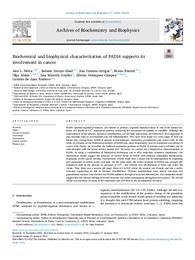Por favor, use este identificador para citar o enlazar este ítem:
https://hdl.handle.net/11000/37784Registro completo de metadatos
| Campo DC | Valor | Lengua/Idioma |
|---|---|---|
| dc.contributor.author | Neira, José L. | - |
| dc.contributor.author | Araujo-Abad, Salomé | - |
| dc.contributor.author | Cámara-Artigas, Ana | - |
| dc.contributor.author | Rizzuti, Bruno | - |
| dc.contributor.author | Abián, Olga | - |
| dc.contributor.author | Giudici, Ana Marcela | - |
| dc.contributor.author | Velazquez-Campoy, Adrian | - |
| dc.contributor.author | de Juan Romero, Camino | - |
| dc.contributor.other | Departamentos de la UMH::Agroquímica y Medio Ambiente | es_ES |
| dc.date.accessioned | 2025-11-03T12:16:33Z | - |
| dc.date.available | 2025-11-03T12:16:33Z | - |
| dc.date.created | 2022 | - |
| dc.identifier.citation | Archives of Biochemistry and Biophysics | es_ES |
| dc.identifier.issn | 1096-0384 | - |
| dc.identifier.issn | 0003-9861 | - |
| dc.identifier.uri | https://hdl.handle.net/11000/37784 | - |
| dc.description.abstract | PADI4 (protein-arginine deiminase, also known as protein l-arginine iminohydrolase) is one of the human isoforms of a family of Ca2+-dependent proteins catalyzing the conversion of arginine to citrulline. Although the consequences of this process, known as citrullination, are not fully understood, all PADIs have been suggested to play essential roles in development and cell differentiation. They have been found in a wide range of cells and tissues and, among them, PADI4 is present in macrophages, monocytes, granulocytes and cancer cells. In this work, we focused on the biophysical features of PADI4 and, more importantly, how its expression was altered in cancer cells. Firstly, we described the different expression patterns of PADI4 in various cancer cell lines and its colocalization with the tumor-related protein p53. Secondly, we carried out a biophysical characterization of PADI4, by using a combination of biophysical techniques and in silico molecular dynamics simulations. Our biochemical results suggest the presence of several forms of PADI4 with different subcellular localizations, depending on the cancer cell line. Furthermore, PADI4 could have a major role in tumorigenesis by regulating p53 expression in certain cancer cell lines. On the other hand, the native structure of PADI4 was strongly pH-dependent both in the absence or presence of Ca2+, and showed two pH-titrations at basic and acidic pH values. Thus, there was a narrow pH range (from 6.5 to 8.0) where the protein was dimeric and had a native structure, supporting its role in histones citrullination. Thermal denaturations were always two-state, but guanidinium-induced ones showed that PADI4 unfolded through at least one intermediate. Our simulation results suggest that the thermal melting of PADI4 structure was rather homogenous throughout its sequence. The overall results are discussed in terms of the functional role of PADI4 in the development of cancer. | es_ES |
| dc.format | application/pdf | es_ES |
| dc.format.extent | 16 | es_ES |
| dc.language.iso | eng | es_ES |
| dc.publisher | Elsevier | es_ES |
| dc.relation.ispartofseries | 717 | es_ES |
| dc.rights | info:eu-repo/semantics/openAccess | es_ES |
| dc.rights | Attribution-NonCommercial-NoDerivatives 4.0 Internacional | * |
| dc.rights.uri | http://creativecommons.org/licenses/by-nc-nd/4.0/ | * |
| dc.subject | Cancer | es_ES |
| dc.subject | Circular dichroism | es_ES |
| dc.subject | Calorimetry | es_ES |
| dc.subject | Fluorescence | es_ES |
| dc.subject | Protein stability | es_ES |
| dc.subject | Western blot | es_ES |
| dc.subject.other | CDU::5 - Ciencias puras y naturales | es_ES |
| dc.title | Biochemical and biophysical characterization of PADI4 supports its involvement in cancer | es_ES |
| dc.type | info:eu-repo/semantics/article | es_ES |
| dc.relation.publisherversion | https://doi.org/10.1016/j.abb.2022.109125 | es_ES |

Ver/Abrir:
1-s2.0-S0003986122000108-main.pdf
2,89 MB
Adobe PDF
Compartir:
 La licencia se describe como: Atribución-NonComercial-NoDerivada 4.0 Internacional.
La licencia se describe como: Atribución-NonComercial-NoDerivada 4.0 Internacional.
.png)